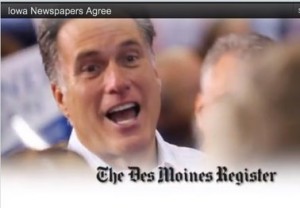Brands
Can Too Many Ads Hurt Obama, Romney in Final Days? [VIDEO]
As part of the Content Campaign ’12 Series, The Content Strategist examines content published by the presidential campaigns as part of their strategy to win November’s general election
The presidential candidates are vying to control how the American government spends its money. Perhaps they should start with how they spend their own.
 This is the most expensive presidential campaign in history, with the candidates et al spending a combined $730 million on ads alone. In swing states, the amount of advertising in communities is particularly high (Las Vegas, Nevada topped the list with 73,000 campaign ads this year). For Americans — especially those in swing states — this unprecedented ad money means that candidates come at us not only on TV and radio, but also via texts, websites and social media.
This is the most expensive presidential campaign in history, with the candidates et al spending a combined $730 million on ads alone. In swing states, the amount of advertising in communities is particularly high (Las Vegas, Nevada topped the list with 73,000 campaign ads this year). For Americans — especially those in swing states — this unprecedented ad money means that candidates come at us not only on TV and radio, but also via texts, websites and social media.
Indeed, social media and internet campaign spending are growing as people more frequently turn to those media, adding to an ever-growing campaign tab.
The Content Strategist spoke this week to two political science professors, each of whom co-authored separate academic studies on the lasting effects of campaign ads. Both came to similar conclusions: While advertising is effective at first, those effects don’t last.
Donald Green, professor at Columbia University, published a paper last year that studied Texas Governor Rick Perry’s 2006 re-election campaign. It showed that ads gave Perry a significant bump immediately after airing. That bump, however, dissipated completely a week or two later, leading Green to think that campaign ads would be more effective — and excusable — closer to election day.
“What’s harder to understand is the tens of millions of dollars spent over the summer,” he said.

Green also referred The Content Strategist to a 2008 study he coauthored that compared counties in non-swing-states in media markets across the country. One county received spillover ads from a neighboring swing state. Another similar county did not. Green found that the ads had no effect on voter turnout, leading him to refer to the current campaign ad excess as a “kind of public works program for media buyers.”
Seth Hill, assistant professor at University of California, San Diego, was slightly more generous, calling campaign ads “somewhat effective.”
In “How Quickly We Forget: The Duration of Persuasion Effects from Mass Communication,” Hill and three other authors concluded that “while some persuasion effects do endure, most do not.”
While he found that half the effect is gone in just a few days, he suggests that candidates may have other reasons for spending early on, such as encouraging their base and, by extension, their campaign funds.
Both Hill and Green admitted that the effect of ads is difficult to measure because it’s impossible to do in isolation. And as of yet, there have been no studies on campaigns of this magnitude.
“The main problem is that when both candidates are airing ads, if the net effect is small, we don’t know if the ads are ineffective or if they are just canceling each other out,” Hill told The Content Strategist. That uncertainty has caused what Hill called an “arms race” between the candidates. It’s also unclear how negative and positive ads affect voters, though some have argued that negative ads actually keep people from the polls.
And what about the sheer saturation of ads? Do people being to just block it out, like so much other background noise? Or do they have the possibility of backfiring? And, should brands take notice of this as they plan their own content strategies?
The truth is, no one knows — except perhaps the candidates, who aren’t telling. More likely, the candidates are going not with what they know but, rather, by what is normal. They are following a better safe than sorry logic — to the tune of what could ultimately be $8 million.
“Clearly Bud and Coca-Cola feel like they need to be advertising every day of the entire year,” Hill said. “Whether you can overshoot and annoy people to the extent of purging them is unclear. It’s very clear why you’d want to be on the air a lot.”
At least for now we don’t know if it hurts.
Get better at your job right now.
Read our monthly newsletter to master content marketing. It’s made for marketers, creators, and everyone in between.




